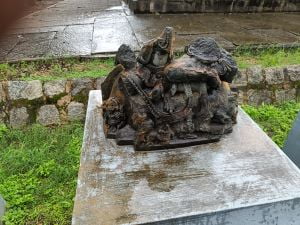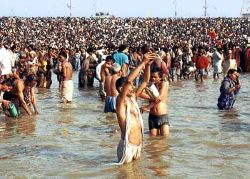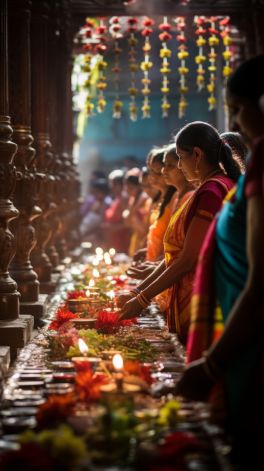Cultural heritage is defined briefly as the legacy of the ways of living from the past, what we live with today and what we pass on to future generations
Evolution of concept of cultural heritage
The concept of cultural heritage developed as a result of complex historical processes spanning over many centuries and is constantly evolving. It encompasses many tangible and intangible elements. In fact cultural Heritage is” an expression of the ways of living” developed by a community and passed on from generation to generation, including customs, practices, places, objects, artistic expressions and values.
Cultural heritage objects are sometimes referred to be symbolic. They represent identities in terms of culture and natural surroundings. Connection to and traditional activities around these objects create a sense of community.

primarily created by the human community as an expression of living. The emergence of the concept of” cultural heritage” is the outcome of a long historical development over millions of years in which different values were attached to monuments, buildings, works of arts, artifacts, landscapes, etc
Tangible &intangible heritage
Cultural Heritage is often expressed as either Intangible or Tangible. It encompasses tangible artifacts like traditional clothing and monuments, as well as intangible aspects such as oral traditions and performing arts.
They are representing the life of a community over the years in its various aspects. It represents the lifestyles, standard of living , mastery of skills etc. For instance, tangible heritage can be seen in traditional clothing, modes of transportation, tools, buildings, monuments, and artwork of any community or group. In contrast, the intangible heritage is the intellectual wealth, which is nonphysical. Intangible heritage includes oral traditions, performing arts, local knowledge, traditional skills, and language that have been passed over generations.
Need to preserve the heritage
The cultural heritage of any land has to be preserved for the posterity. In this information era, digital techniques can substantially reduce the difficulty of preserving intangible cultural heritage. Digital archives in the cultural and historical domains are mostly a collection of digital copies of original cultural heritage objects.
Cultural heritage sites include hundreds of historic buildings and town sites, important archaeological sites, and works of monumental sculpture or painting. These tanglible heritage is preserved by the Archeological department of the government in most of the countries globally.
Natural heritage
Natural heritage is also an important part of any culture, and it encompasses the countryside and natural environment, including flora and fauna. Natural heritage are the outstanding examples of the Earth’s record of life or its geologic processes; ongoing ecological and biological evolutionary processes. These sites also furnish habitats for rare or endangered animals or plants and therefore they are known for their exceptional biodiversity.
UNESCO – The preserver of heritage sites
UNESCO is a specialized agency of the United Nations established in 1945. Its stated initial goal was to contribute to peace and security by promoting international collaboration through education, science, and culture in order to further universal respect for justice, the rule of law, and the human rights and fundamental freedoms proclaimed in the UN Charter. It has marked many world heritage sites of significance. Indian subcontinent also has many tangible and intangible heritage sites marked under UNESCO.
Please follow the link to know about world heritage sites of India.
READ MORE : https://indiheritage.com/unesco-world-heritage-sites-of-india/
Blogs – Cultural heritage
Thalagunda – Pranaveswara temple a connecting link to the history of south India
Praveswara temple, Thalagunda in Karnataka is an ancient shiva temple of Kadaba dynasty , a monument protected monument by Archeological Survey of India[ASI] due to its historical significance.

Thalagunda is a village in the Shikaripura taluk of Shivamogga district in the state of Karnataka, India. There are many ancient temples in Thalagunda village including pranaveshvara, gangaadhareshvara, trineetra and veerabhadra temples. Praveswara temple is a protected monument by Archeological Survey of India[ASI] due to its historical significance.
Sanchi buddhist monuments
Sanchi Stupa is a Buddhist complex, famous for its Great Stupa, on a hilltop at Sanchi Town in Raisen District of the State of Madhya Pradesh, India. It is located 46 kilometres (29 mi) north-east of Bhopal, capital of Madhya Pradesh.

The stupas, temples, viharas, and stambha at Sanchi in central India are among the oldest and most mature examples of aniconic arts and free-standing architecture that comprehensively document the history of Buddhism from the 3rd century BCE to the 12th century CE.
The monuments at Sanchi now comprise a series of Buddhist monuments starting from the Mauryan Empire period (3rd century BCE), continuing with the Gupta Empire period (5th century CE), and ending around the 12th century CE. It is probably the best preserved group of Buddhist monuments in India.
Badami cave temples karnataka
The Badami cave temples are a complex of Buddhist, Hindu and Jain cave temples located in Badami, an ancient heritage town in the Bagalkot district in northern part of Karnataka, India.

The Badami cave temples are a complex of Buddhist, Hindu and Jain cave temples located in Badami. This is an instance of rock cut temple built in Chalukya architectural style
Maha kumbh mela 2025

Kumbh Mela (the festival of the sacred Pitcher or pot ) is considered as the largest peaceful congregation of pilgrims on earth, and it includes the ritual of taking bathe or a holy dip in a sacred river. It is a huge spiritual event inviting global attention as a tradition interwoven with the rich cultural heritage of India since ancient times.The event is a religious and cultural spectacle which occurs once in 12 years attracting participants from around the globe to take a dip in the holy waters
Bhagoriya festival – Vibrant expression of tribal culture , Madhyapradesh

Bhagoriya festival is a harvest festival celebrated by tribal people in Madhya Pradesh and Maharashtra, a unique celebration of the Bhil and other indigenous communities such as Bhilalas and Pateliyas.
It is a festival of singing and dance which celebrates the arrival of Spring and harvest. The tribal people start the celebrations seven days before the festival of Holi.
Tamil Nadu’s cultural vibrancy

Tamil Nadu is a state of unparalleled cultural vibrancy due to its vast heritage temples, art forms, festivals and being the cradle of various dance forms.
According to historical data Tamilakam region indicates a continuous history of human occupation for more than 3,800 years. The region was inhabited by Tamil-speaking Dravidian people. The cultural heritage of Tamilakam evolved from a diverse range of empires ruled the region over many centuries.
READMORE